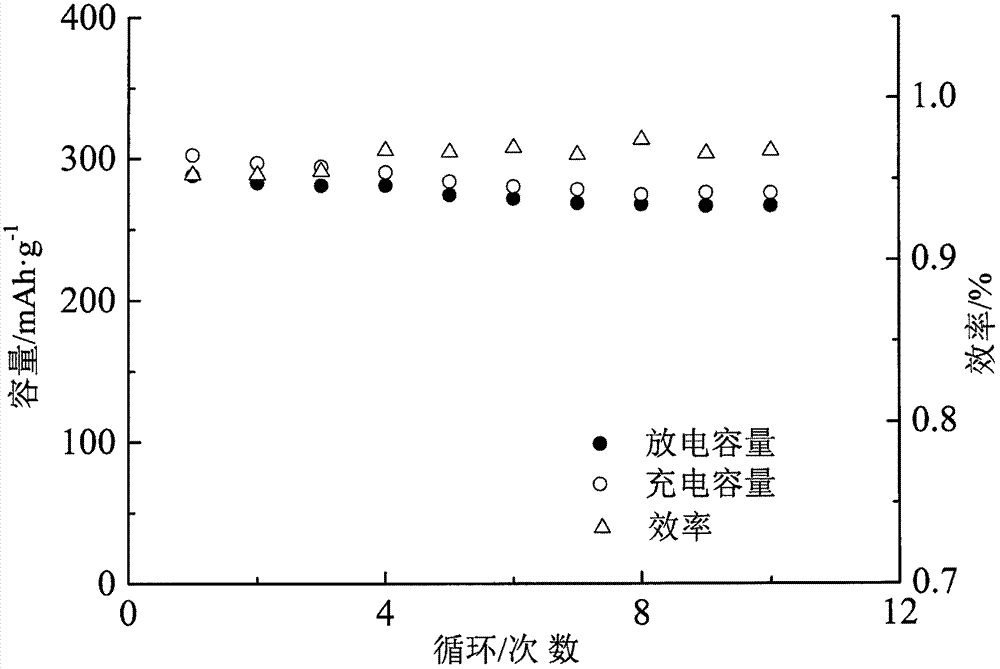Continuous conduction in-situ C/Ag, metal solid solution/Mg<2+> doped BiF3 positive electrode and preparation method
A solid solution, metal technology, applied in battery electrodes, circuits, electrical components, etc., can solve the problems of highly toxic hydrogen fluoride, high polarization voltage, complex mechanism of action, etc., to improve the discharge reaction rate, improve electronic conductivity, reduce power The effect of learning obstacles
- Summary
- Abstract
- Description
- Claims
- Application Information
AI Technical Summary
Problems solved by technology
Method used
Image
Examples
Embodiment 1
[0013]Embodiment 1: The preparation composition is the initial aqueous solution of 5wt% bismuth nitrate, 0.1wt% magnesium nitrate, 0.5wt% nitric acid, 6wt% acrylamide, 1wt% N, N'-dimethylacrylamide, using polytetrafluoroethylene Stir with an ethylene paddle at 900 rpm for 5 minutes. The initial aqueous solution was raised to 75°C at a rate of 5°C / min and maintained at this temperature until the initial aqueous solution became a jelly-like gel. Dry the formed gel in a low-temperature and high-vacuum environment. The drying process adopts the finished freeze dryer on the market. Put the gel into the sample tray of the freeze dryer and start the refrigerator. Reduce to minus 46°C, turn on the vacuum pump to increase the vacuum degree, wait until the gas pressure in the system drops below 27Pa, turn on the partition temperature control to start dehydration and drying, other operating parameters adopt the machine preset value, after the air pressure in the system is stabilized and ...
Embodiment 2
[0014] Example 2: Preparation of an initial aqueous solution consisting of 15wt% bismuth nitrate, 0.5wt% magnesium nitrate, 1wt% nitric acid, 12wt% acrylamide, and 2wt% N, N'-dimethylacrylamide, using polytetrafluoroethylene to stir The paddle was stirred at 1200 rpm for 14 minutes. The initial aqueous solution was raised to 85°C at a rate of 10°C / min and maintained at this temperature until the initial aqueous solution became a jelly-like gel. Dry the formed gel in a low-temperature and high-vacuum environment. The drying process adopts the finished freeze dryer on the market. Put the gel into the sample tray of the freeze dryer and start the refrigerator. Reduce to minus 50°C, turn on the vacuum pump to increase the vacuum degree, wait until the gas pressure in the system drops below 34Pa, turn on the partition temperature control to start dehydration and drying, other operating parameters adopt the machine preset value, after the air pressure in the system is stabilized and...
Embodiment 3
[0015] Example 3: The preparation composition is 12wt% bismuth nitrate, 0.3wt% magnesium nitrate, 0.8wt% nitric acid, 9wt% acrylamide, 1.5wt% N, N'-methylenebisacrylamide initial aqueous solution, using polytetrafluoroethylene The vinyl fluoride stirring paddle was stirred at a speed of 1100 rpm for 9 minutes. The initial aqueous solution was raised to 80°C at a rate of 7°C / min and maintained at this temperature until the initial aqueous solution became a jelly-like gel. Dry the formed gel in a low-temperature and high-vacuum environment. The drying process adopts the finished freeze dryer on the market. Put the gel into the sample tray of the freeze dryer and start the refrigerator. Reduce to minus 48°C, turn on the vacuum pump to increase the vacuum degree, wait for the gas pressure in the system to drop below 30Pa, turn on the temperature control of the clapboard to start dehydration and drying, other operating parameters adopt the machine preset value, and after the air pr...
PUM
 Login to View More
Login to View More Abstract
Description
Claims
Application Information
 Login to View More
Login to View More - R&D
- Intellectual Property
- Life Sciences
- Materials
- Tech Scout
- Unparalleled Data Quality
- Higher Quality Content
- 60% Fewer Hallucinations
Browse by: Latest US Patents, China's latest patents, Technical Efficacy Thesaurus, Application Domain, Technology Topic, Popular Technical Reports.
© 2025 PatSnap. All rights reserved.Legal|Privacy policy|Modern Slavery Act Transparency Statement|Sitemap|About US| Contact US: help@patsnap.com

